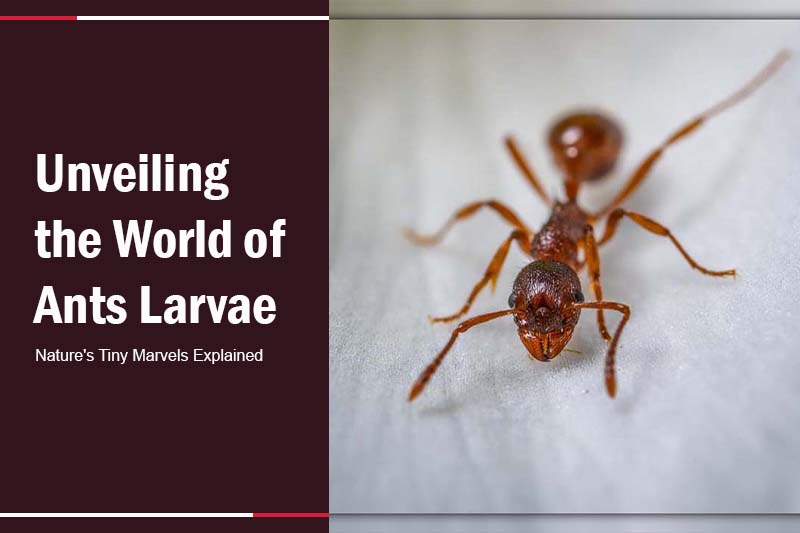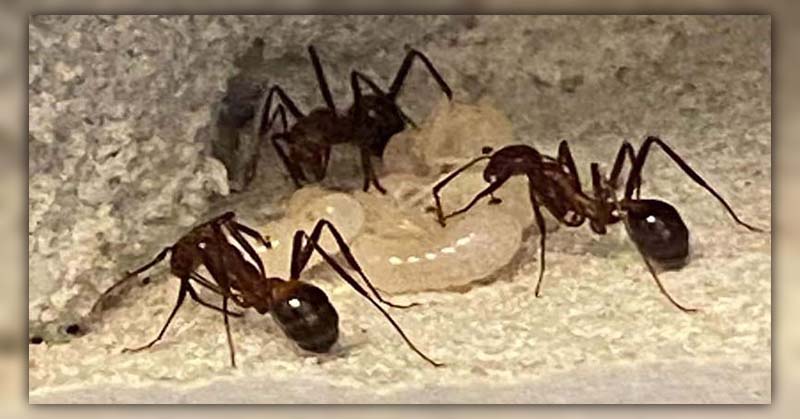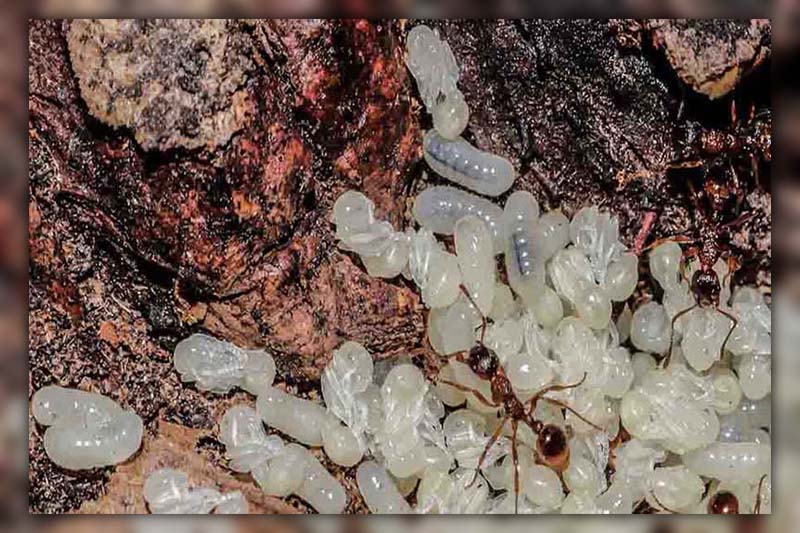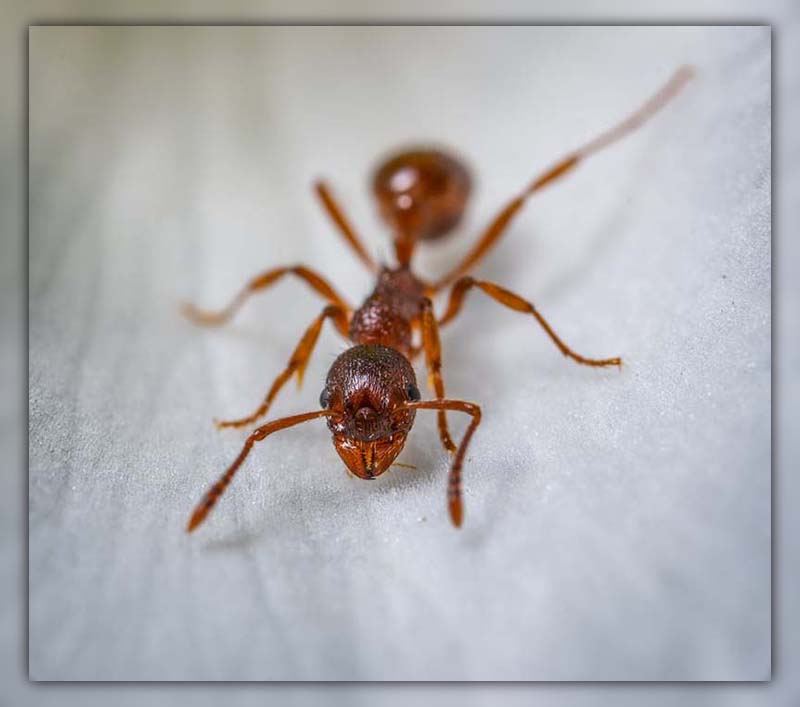Have you ever found tiny, wriggling creatures in corners or hidden spaces of your home? Wondering if those are ants larvae and what they could possibly mean?
Understanding the world of ants larvae could hold the key to addressing pest-related concerns in your home.

What Are Ant Larvae?
As eggs hatch, they transform into these minuscule creatures. Think of them as tiny, eyeless beings resembling maggots. While lacking eyes and major organs, their activity is focused on wiggling and mouth movements.
Fascinatingly, the queen or worker ants take on the role of nurturing them, providing the sustenance they require.
A remarkable aspect of ant larvae is their appearance – adorned with fine hairs that cleverly interlock. This unique feature aids the queen or workers in efficiently gathering multiple larvae simultaneously.
Most larvae mature into diligent worker ants, contributing to the colony’s bustling activities.
However, within more established colonies, some larvae are privileged with extra nourishment, allowing them to evolve into virgin winged queen ants – a vital asset to the colony’s prosperity.
What Do Ant Larvae Eat?
These tiny beings dedicate most of their growing phase to feeding, a process orchestrated by diligent worker ants. Proteins take center stage in their diet, serving as essential building blocks for their developing bodies.
They rely heavily on protein-rich diets provided by worker ants. These diligent workers pre-digest food, turning it into a liquid form which is easier for larvae to consume.
While some ant species are observed offering ground solid foods, the preference is always for the liquid feed, rich in all necessary nutrients. Remarkably, even though larvae have the capability to process solid foods, their primary intake remains liquid.
In times of scarcity, ant larvae don’t escape their role – they become a vital food source. Though it might seem harsh, this sacrifice ensures the queen’s well-being, a crucial element for the entire colony’s survival.
Witness the intricate balance of nature as worker ants go to great lengths to safeguard their queen’s health, even if it entails using the larvae’s sustenance.
What Does Ant Larvae Look Like?
These young creatures exhibit a distinctive hook-like shape and appear predominantly white, with a subtle touch of transparency.
Much like the adhesive exterior of ant eggs, these larvae are adorned with tiny hairs that adhere to their surfaces, adding a unique touch to their form.
Imagine them as miniature versions of maggots, and you’re on the right track. It’s fascinating how ant larvae bear a striking resemblance to ant pupae in terms of looks.
Both exhibit a white, waxy covering that imparts a white or slightly yellowish hue to their appearance.
Neither ant larvae nor ant pupae possess fully developed muscles or wings at this stage of their lives. These crucial features develop later as they transition into adulthood.
Why is the ant larval stage important?
These astute ants utilize silk produced by their larvae to stitch together leaves for their nest construction. This unique collaboration showcases how even the earliest stages of life play a pivotal role in their society’s development.
Recent studies have unveiled an astonishing discovery: certain nutrients that adult ants struggle to digest due to their slim waists receive assistance from ant larvae.
Adult ants carefully transfer these nutrients onto the larvae’s abdomen, positioning them while the larvae lie on their backs.
The larvae’s body is equipped with digestive gland openings that generate enzymes. Over time, these enzymes convert the nutrients into a dense liquid, rendering them digestible.
How Long Does It Take for Ant Eggs to Become Ant Larvae?
A fertile queen, commencing the life cycle by burrowing into the earth to craft a small chamber. In this cozy haven, she delicately lays her eggs.
Over the span of roughly 3 to 4 weeks, these eggs hatch, giving birth to ant larvae.
And 5 more weeks, those once tender larvae have evolved into fully-fledged adult ants, completing the cycle from inception to maturity.
Additional stages within the larval stage
As larvae progress, they embark on a journey known as molting, where they shed their outer skin. This process occurs at distinct intervals, usually happening a minimum of three times.
Intriguingly, certain ant species, like fire ants assist their larvae by aiding in the shedding of skin and eliminating waste materials. Contrastingly, most ant species allow their larvae to develop autonomously, with minimal intervention.
These young ones aren’t passive participants; they remain active by licking, shifting, and energetically guarding themselves against intruders. This underscores the vital role they play within the colony’s dynamics.
While the specifics may vary, a substantial number of ant species, numbering in the thousands, share a common pattern of development. These species typically progress through four distinct stages during their larval growth journey.
At each stage, the larvae undergo noticeable changes in their external appearance and internal structures.
The stages of ant larvae
In the initial stage, the body has soft, shorter hairs, reflecting a gentle sheen. With each progression to the next stage, the texture of these hairs undergoes a remarkable shift.
They transform into rough structures with hook-like points, lending the larvae an entirely different look.
Towards the final stage, the larvae seem to have developed a method of excretion. This process takes on the form of a single, black solid pellet that emerges from the rear end of the larvae’s bodies.
How to deal with ants larvae in your house?
Understand that ants larvae tend to remain close to their nest. If you spot ants larvae in your house, it’s an indication that an ant nest might be nearby.
These vulnerable young ones require care, implying the existence of a nest in your vicinity.
The focus here is on the colony’s activity rather than solely the larvae.
Now, let’s delve into solutions for this issue:
- Natural Approaches: Explore natural ant control methods, like essential oils or sprays.
- Ant Traps and Bait Stations: Utilize ant traps or bait stations strategically placed in affected areas.
- Pesticides: Consider using pesticides designed to target ants. However, exercise caution, especially if you have pets or small children.
- Professional Extermination: In cases of more extensive infestations, seeking professional pest control services is a prudent choice.
Remember, the chosen approach should align with the scale of the infestation. For minor concerns, natural remedies or traps might suffice.
However, if the issue persists or worsens, consulting professionals is highly recommended.
Conclusion
Explore the fascinating world of ant larvae, from their unique roles in silk production to aiding adult ants in digestion. Witness their growth from eggs to thriving colonies.
Dive deeper into the wonders of the insect realm with our blogs at Pestweek.

Calina Mabel has over 15 years of experience in the field of journalism and communications. Currently, Calina Mabel is the Content Writer for categories such as Cockroach, Ants, Bed Bugs, Mosquito, Rodent, Termite, and Flies on Pestweek.com. She aims to build content for these categories with a focus on providing valuable and accessible information to readers, in order to create the world’s largest knowledge community about Pests.
All content written by Calina Mabel has been reviewed by Emily Carter.





